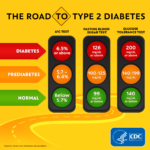Diabetes nutrition
Part of any management program for diabetic patients is changes or adaptations in your lifestyle.
In this article, we will explore how food provides energy. We will also look at how exercise allows you to burn off energy.
There are many things that you need to know if you have diabetes, such as what to eat, how to exercise, and how to manage your stress levels.
Diabetes is a growing epidemic worldwide that affects millions of people every year. It has been estimated that by the year 2040, one-third of the world’s population will suffer from the disease.
Diabetes is a chronic metabolic disorder that affects how your body metabolizes sugar. It is typically caused by an inability to create enough insulin due to a lack of pancreas cells or the cells not responding properly, which leads to sugar levels in the blood becoming too high.
Diabetes has traditionally been classified as one of two types: type 1 diabetes and type 2 diabetes. The body’s immune system destroys its own tissue, in this case, the pancreas is responsible for the production of insulin, in type 1diabetes, which is an autoimmune disease. A lower level of insulin is needed for type 2 diabetes because it is associated with high levels of resistance to the drug.
A combination of genetics, lifestyle, and environmental factors affect the pancreas ability to produce and use insulin to aid in controlling Type 2 diabetes is caused by a combination of genetics, lifestyle, and environment.
Eating healthy, exercising regularly, maintaining a healthy weight, and not smoking are some of the things you can do to help reverse type 2 diabetes. While type 1 diabetes can only be treated.
Diabetes and carbohydrates
Carbohydrates are what give the body its energy. Some people with diabetes have to keep a close eye on their carbohydrate intake to avoid a spike in their blood sugar levels. They provide the glucose that fuels the brain and muscles. The amount of carbohydrates to consume depends on one’s age, gender, size, and activity level.
The American Diabetes Association recommends that people with diabetes should aim to eat 45-60 grams of carbohydrate per meal and 15-30 grams per snack, while other organizations recommend a more restrictive limit of 20-40 grams per meal and 5-10 grams per snack. For someone who consumes 2000 calories per day, this would be about 225-300 grams of carbohydrates per day. But this number is just a general guideline. People with diabetes should work closely with their healthcare providers to determine what is best for them individually.
There are many different types of sugars and starches. The American Diabetes Association suggest that people with diabetes limit their daily intake of sugar to 10% of their total daily calories in order to maintain a healthy blood sugar level.
Carbohydrates are present in many foods that we commonly eat and may also be stored in the form of glycogen in our muscles. The number of carbohydrates needed to maintain healthy blood sugar levels varies from person to person which is why it is important to consult a doctor or nutritionist before making any drastic changes.
People with diabetes have to be more careful about their carbohydrate intake because they are at increased risk of developing high blood sugar levels. They need to know how much carbohydrates they can eat without risking complications such as kidney disease, nerve damage, blindness, or amputation of limbs.
There are many different factors that determine how many carbohydrates a person with diabetes should consume on a daily basis. These factors can include age, weight, height, level of physical activity, and any medical conditions such as kidney disease or type 1 diabetes.

Simple carbohydrates are found in foods like fruit juice, soft drinks, white bread, and pasta. Blood sugar levels go through a rapid spike after you eat simple sugars because they are broken down quickly by the body. If someone is not active enough to burn off their extra calories from these food items, they could be susceptible to mood swings, fatigue, and even weight gain.
Complex carbohydrates include pasta, rice, cereal, brown rice, beans, quinoa or barley, and potatoes with skin on them; these have a lower glycemic index than simple carbs do because they take longer to break down in your body.
Fiber-rich carbs include vegetables like broccoli or spinach which have a low glycemic index because they slow digestion and release glucose slowly
The ADA guidelines for carbohydrates in the diet were developed for people without diabetes. They recommend that adults without diabetes eat 45-60 grams of carbs per meal, and then adjust their carb intake depending on weight and activity level.
A person with diabetes typically needs to control their carbohydrate intake. The amount of carbohydrates that a person with diabetes should eat varies depending on the type of diabetes, age, weight, and activity level.
Diabetes and fats and protein
It is a well-known fact that diabetics should avoid eating high-sugar foods. But what about fats? Healthy fats are essential for the body, but there is a common misconception that they can make diabetes worse.
There are many types of protein sources that can be good for diabetics, including:
– Fish: Fish has low in fat and is high in important Omega-3 and 6 fatty acids. The American Diabetes Association recommends eating fish at least two times a week.
– Eggs: Eggs are a good source of energy and they have good amounts of fats that can help keep you full longer.
– Dairy products: Dairy products, like milk, yogurt, cheese, and ice cream, can be eaten alone or made into other foods like smoothies, oatmeal, or pancakes.
– Beans: Beans are a staple in many diets, and for good reason. They can provide a dose of protein that is low in fat, so they are a smart addition to any healthy diet.
The body needs vitamins and minerals to build and maintain its muscles, organs, and other tissues. Energy is provided by the power of protein when there are not any carbohydrates that are not always available.
Most of the sources of protein in the world come from animal-based foods like meat, poultry, fish, eggs, and dairy products. It is possible to replace animal-based foods with plant-based ones to reduce the risk of chronic diseases.
There are many plant-based sources of protein that can be consumed by people with diabetes. These include soybeans and other beans like lentils or chickpeas; vegetables like broccoli or spinach; nuts like peanuts or almonds; seeds like sesame seeds or pumpkin seeds; whole grains such as rice or oats; and tofu.
Protein is an essential macronutrient for the human body. It helps in maintaining and building muscle mass, bone density, and blood. It also helps regulate blood sugar levels.
People with diabetes should be careful with the amount of protein they take in their diet as it can affect their blood sugar levels negatively.
The truth is that fat is necessary for the body to function properly. It does not matter if it’s healthy fat or not, as long as it’s consumed in moderation. A diet rich in healthy fat can actually result in weight loss, lower cholesterol levels, and improved insulin sensitivity.
A study conducted by Dr. David Jenkins and his team found that adding healthy fats to a meal with carbohydrates reduced the glycemic index of the meal by up to 20%. This means that diabetics who consume healthy fats will experience less of an insulin spike after eating carbs.
However, people with diabetes typically need to consume more calories than the average person in order to maintain a healthy blood sugar level. This means that they often need an increased amount of fat, which can be difficult for them when considering the potential dangers associated with eating too much fat.
There are two types of fats that are good for diabetics. Some foods with monounsaturated fats include olive oil, nuts, and seeds. Polyunsaturated fats are good for your body and can be found in foods such as fish, shellfish, soybeans, sunflower seeds, walnuts, and pumpkin seeds.
The goal of a diabetic diet is to provide the body with the necessary nutrients for managing blood sugar levels, preventing or managing complications, and helping to maintain a healthy weight. It can be difficult for diabetics to know what types of foods are best for them, but it’s important that they take in fat as it’s essential for good health.
Physical activity
Physical activity is an important part of a healthy lifestyle for everyone. For people with diabetes, it’s even more important to be physically active because it can reduce the risk of developing complications from diabetes. It also has the added benefit of helping people with diabetes to maintain blood sugar levels, improve their cholesterol levels, gain flexibility and muscle tone and lose weight.
All people who suffer from diabetes, regardless of their size or weight, need to be aware that being inactive can lead to unhealthy weight gain. The amount and type of food that the person does eat will not matter so much as how often they exercise and for how long. The body needs a certain amount of calories just to function which is called the basal metabolic rate. The average male adult needs to consume between 2,000-2,500 This is especially true for people who take insulin or other medications that cause weight gain. Being physically active helps avoid or control weight gain, which helps prevent or delay the onset of complications from diabetes.
For people with diabetes, being physically active can be advantageous for many reasons. By following the recommended guidelines and making physical activity a part of the patient’s lifestyle, they can help manage their blood sugar, reduce their risk of developing complicated diabetes-related complications, and lose weight.
Diabetes can cause weight gain and that is a common misconception. Exercise is an important part of diabetes management and it can help to prevent weight gain.
The guidelines for physical activity are:
– Over the week, adults should do 150 minutes of modest to intense or 75 minutes of brisk aerobic exercise.
– On two, three, or more days per week, adults should do muscle-strengthening exercises.
– Guidelines for children are different depending on their age.:
o Children between 6 and 17 should do at least 60 minutes of moderate-intensity or 30 minutes of vigorous aerobic activity over the course of the week.
o Children between 3 and 5 years should do at least 60 minutes of moderate-intensity aerobic activity spread out over the day.
Conclusion
If you can follow the above guidelines, you will develop a lifestyle that is healthy. If you are diabetic you will also give yourself a healthy life. Hope you enjoyed this article, Diabetes nutrition. Please join our Facebook group and check out our other blog articles.
*************








